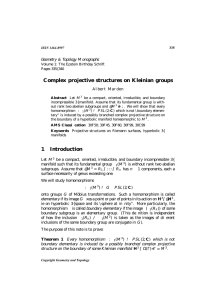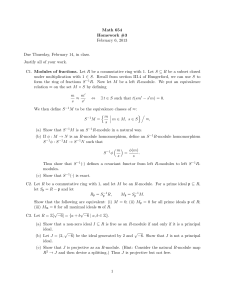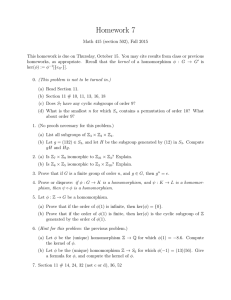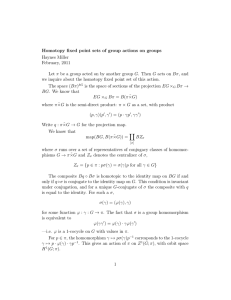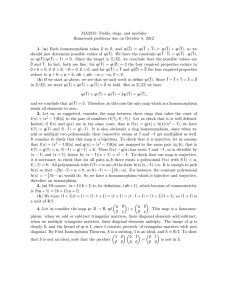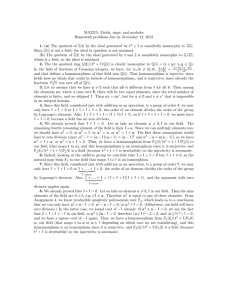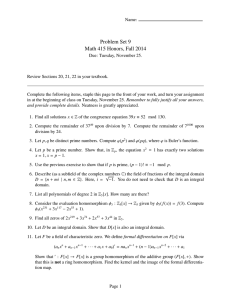Complex projective structures on Kleinian groups Geometry & Topology Monographs Albert Marden 335
advertisement
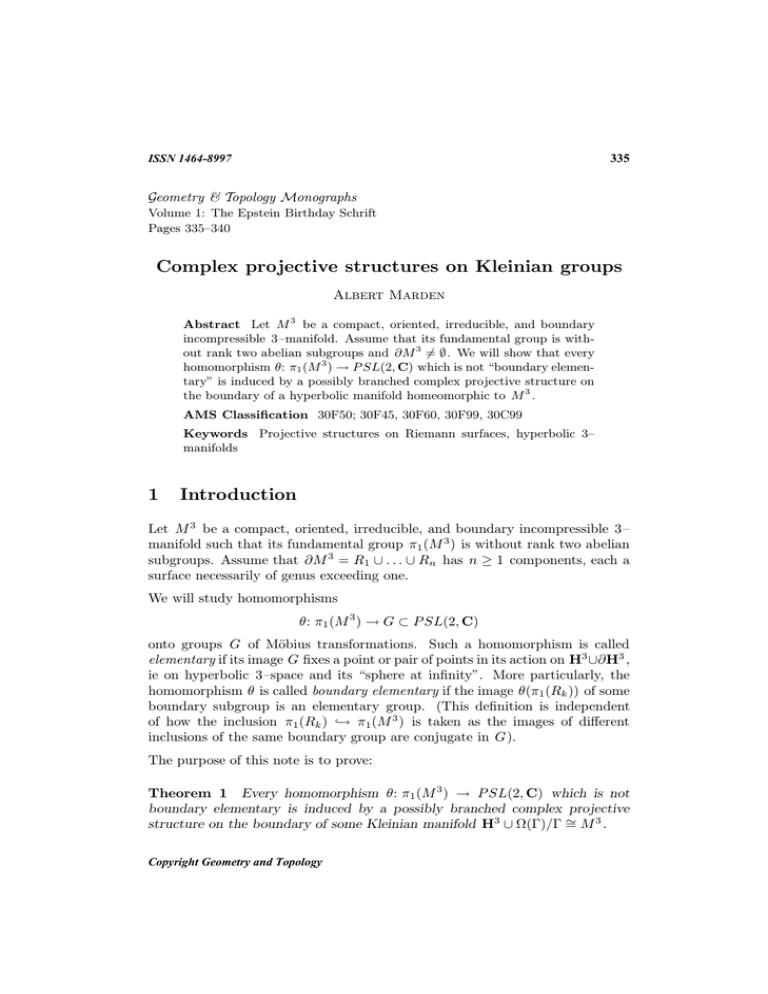
335 ISSN 1464-8997 Geometry & Topology Monographs Volume 1: The Epstein Birthday Schrift Pages 335–340 Complex projective structures on Kleinian groups Albert Marden Abstract Let M 3 be a compact, oriented, irreducible, and boundary incompressible 3–manifold. Assume that its fundamental group is without rank two abelian subgroups and ∂M 3 6= ∅. We will show that every homomorphism θ: π1 (M 3 ) → P SL(2, C) which is not “boundary elementary” is induced by a possibly branched complex projective structure on the boundary of a hyperbolic manifold homeomorphic to M 3 . AMS Classification 30F50; 30F45, 30F60, 30F99, 30C99 Keywords Projective structures on Riemann surfaces, hyperbolic 3– manifolds 1 Introduction Let M 3 be a compact, oriented, irreducible, and boundary incompressible 3– manifold such that its fundamental group π1 (M 3 ) is without rank two abelian subgroups. Assume that ∂M 3 = R1 ∪ . . . ∪ Rn has n ≥ 1 components, each a surface necessarily of genus exceeding one. We will study homomorphisms θ: π1 (M 3 ) → G ⊂ P SL(2, C) onto groups G of Möbius transformations. Such a homomorphism is called elementary if its image G fixes a point or pair of points in its action on H3 ∪∂H3 , ie on hyperbolic 3–space and its “sphere at infinity”. More particularly, the homomorphism θ is called boundary elementary if the image θ(π1 (Rk )) of some boundary subgroup is an elementary group. (This definition is independent of how the inclusion π1 (Rk ) ,→ π1 (M 3 ) is taken as the images of different inclusions of the same boundary group are conjugate in G). The purpose of this note is to prove: Theorem 1 Every homomorphism θ: π1 (M 3 ) → P SL(2, C) which is not boundary elementary is induced by a possibly branched complex projective structure on the boundary of some Kleinian manifold H3 ∪ Ω(Γ)/Γ ∼ = M3. Copyright Geometry and Topology 336 Albert Marden This result is based on, and generalizes: Theorem A (Gallo–Kapovich–Marden [1]) Let R be a compact, oriented surface of genus exceeding one. Every homomorphism π1 (R) → P SL(2, C) which is not elementary is induced by a possibly branched complex projective structure on H2 /Γ ∼ = R for some Fuchsian group Γ. Theorem 1 is related to Theorem A as simultaneous uniformization is related to uniformization. Its application to quasifuchsian manifolds could be called simultaneous projectivization. For Theorem A finds a single surface on which the structure is determined whereas Theorem 1 finds a structure simultaneously on the pair of surfaces arising from some quasifuchsian group. 2 Kleinian groups Thurston’s hyperbolization theorem [3] implies that M 3 has a hyperbolic structure: there is a Kleinian group Γ0 ∼ = π1 (M 3 ) with regular set Ω(Γ0 ) ⊂ ∂H3 3 such that M(Γ0 ) = H ∪ Ω(Γ0 )/Γ0 is homeomorphic to M 3 . The group Γ0 is not uniquely determined by M 3 , rather M 3 determines the deformation space D(Γ0 ) (taking a fixed Γ0 as its origin). We define D ∗ (Γ0 ) as the set of those isomorphisms φ: Γ0 → Γ ⊂ P SL(2, C) onto Kleinian groups Γ which are induced by orientation preserving homeomorphisms M(Γ0 ) → M(Γ). Then D(Γ0 ) is defined as D ∗ (Γ0 )/P SL(2, C), since we do not distinguish between elements of a conjugacy class. Let V(Γ0 ) denote the representation space V ∗ (Γ0 )/P SL(2, C) where V ∗ (Γ0 ) is the space of boundary nonelementary homomorphisms θ: Γ0 → P SL(2, C). P By Marden [2], D(Γ0 ) is a complex manifold of dimension [3(genus Rk ) − 3] and an open subset of the representation variety V(Γ0 ). If M 3 is acylindrical, D(Γ0 ) is relatively compact in V(Γ0 ) (Thurston [4]). The fact that D(Γ0 ) is a manifold depends on a uniqueness theorem (Marden [2]). Namely two isomorphisms φi : Γ0 → Γi , i = 1, 2, are conjugate if and only if φ2 φ−1 1 : Γ1 → Γ2 is induced by a homeomorphism M(Γ1 ) → M(Γ2 ) which is homotopic to a conformal map. Geometry and Topology Monographs, Volume 1 (1998) 337 Complex projective structures on Kleinian groups 3 Complex projective structures For the purposes of this note we will use the following definition (cf [1]). A complex projective structure for the Kleinian group Γ is a locally univalent meromorphic function f on Ω(Γ) with the property that f (γz) = θ(γ)f (z), z ∈ Ω(Γ), γ ∈ Γ, for some homomorphism θ: Γ → P SL(2, C). We are free to replace f by a conjugate Af A−1 , for example to normalize f on one component of Ω(Γ). Such a function f solves a Schwarzian equation Sf (z) = q(z), q(γz)γ 0 (z)2 = q(z); γ ∈ Γ, z ∈ Ω(Γ), where q(z) is the lift to Ω(Γ) of a holomorphic quadratic differential defined on each component of ∂M(Γ). Conversely, solutions of the Schwarzian, Sg (z) = q(z), z ∈ Ω(Γ), are determined on each component of Ω(Γ) only up to post composition by any Möbius transformation. The function f has the property that it not only is a solution on each component, but that its restrictions to the various components fit together to determine a homomorphism Γ → P SL(2, C). Automatically (cf [1]), the homomorphism θ induced by f is boundary nonelementary. When branched complex projective structures for a Kleinian group are required, it suffices to work with the simplest ones: f (z) is meromorphic on Ω(Γ), induces a homomorphism θ: Γ → P SL(2, C) (which is automatically boundary nonelementary), and is locally univalent except at most for one point, modulo Stab(Ω0 ), on each component Ω0 of Ω(Γ). At an exceptional point, say z = 0, f (z) = αz 2 (1 + o(z)), α 6= 0. Such f are characterized by Schwarzians with local behavior Sf (z) = q(z) = −3/2z 2 + b/z + Σai z i , b2 + 2a0 = 0. At any designated point on a component Rk of ∂M(Γ), there is a quadratic differential with leading term −3/2z 2 . To be admissible, a differential must be the sum of this and any element of the (3gk −2)–dimensional space of quadratic differentials with at most a simple pole at the designated point. In addition it must satisfy the relation b2 + 2a0 = 0. That is, the admissible differentials are parametrized by an algebraic variety of dimension 3gk − 3. For details, see [1]. If a branch point needs to be introduced on a component Rk of ∂M(Γ), it is done during a construction. According to [1], a branch point needs to be introduced if and only if the restriction θ: π1 (Rk ) → P SL(2, C) Geometry and Topology Monographs, Volume 1 (1998) 338 Albert Marden does not lift to a homomorphism θ ∗ : π1 (Rk ) → SL(2, C). 4 Dimension count The vector bundle of holomorphic quadratic differentials over the Teichmüller space of the component Rk of ∂M(Γ0 ) has dimension 6gk − 6. All together these form the vector bundle Q(Γ0 ) of quadratic differentials over the Kleinian deformation space D(Γ0 ). That is, Q(Γ0 ) has twice the dimension of V(Γ0 ). The count remains the same if there is a branching at a designated point. For example, if Γ0 is a quasifuchsian group of genus g , Q(Γ0 ) has dimension 12g − 12 whereas V(Γ0 ) has dimension 6g − 6. Corresponding to each nonelementary homomorphism θ: Γ0 → P SL(2, C) that lifts to SL(2, C) is a group Γ in D(Γ0 ) and a quadratic differential on the designated component of Ω(Γ). This in turn determines a differential on the other component. There is a solution of the associated Schwarzian equation Sg (z) = q(z) satisfying f (γz) = θ(γ)f (z), z ∈ Ω(Γ), γ ∈ Γ. Theorem 1 implies that V(Γ0 ) has at most 2n components. For this is the number of combinations of (+, −) that can be assigned to the n–components of ∂M(Γ0 ) representing whether or not a given homomorphism lifts. For a quasifuchsian group Γ0 , V(Γ0 ) has two components (see [1]). 5 Proof of Theorem 1 We will describe how the construction introduced in [1] also serves in the more general setting here. By hypothesis, each component Ωk of Ω(Γ0 ) is simply connected and covers a component Rk of ∂M(Γ0 ). In addition, the restriction θ: π1 (Rk ) ∼ = Stab(Ωk ) → Gk ⊂ P SL(2, C) is a homomorphism to the nonelementary group Gk . The construction of [1] yields a simply connected Riemann surface Jk lying over S 2 , called a pants configuration, such that: (i) There is a conformal group Γk acting freely in Jk such that Jk /Γk is homeomorphic to Rk . Geometry and Topology Monographs, Volume 1 (1998) Complex projective structures on Kleinian groups 339 (ii) The holomorphic projection π: Jk → S 2 is locally univalent if θ lifts to a homomorphism θ ∗ : π1 (Rk ) → SL(2, C). Otherwise π is locally univalent except for one branch point of order two, modulo Γk . (iii) There is a quasiconformal map hk : Ωk → Jk such that πhk (γz ) = θ(γ)πhk (z), γ ∈ Stab(Ωk ), z ∈ Ωk . Once hk is determined for a representative Ωk for each component Rk of ∂M(Γ0 ), we bring in the action of Γ0 on the components of Ω(Γ0 ) and the corresponding action of θ(Γ0 ) on the range. By means of this action a quasiconformal map h is determined on all Ω(Γ0 ) which satisfies πh(γz) = θ(γ)πh(z), γ ∈ Γ0 , z ∈ Ω(Γ0 ). The Beltrami differential µ(z) = (πh)z̄ /(πh)z satisfies µ(γz)γ̄ 0 (z)/γ 0 (z) = µ(z), γ ∈ Γ0 , z ∈ Ω(Γ0 ). It may equally be regarded as a form on ∂M(Γ0 ). Using the fact that the limit set of Γ0 has zero area, we can solve the Beltrami equation gz̄ = µgz on S 2 . It has a solution which is a quasiconformal mapping g and is uniquely determined up to post composition with a Möbius transformation. Furthermore g uniquely determines, up to conjugacy, an isomorphism ϕ: Γ0 → Γ to a group Γ in D(Γ0 ). The composition πhg−1 is a meromorphic function on each component of Ω(Γ). It satisfies (πhg−1 )(γz) = θϕ−1 (γ)πhg−1 (z), γ ∈ Γ, z ∈ Ω(Γ). The composition is locally univalent except for at most one point on each component of Ω(Γ), modulo its stabilizer in Γ. That is, π ◦ h ◦ g−1 is a complex projective structure on Γ that induces the given homomorphism θ , via the identification ϕ. 6 Open questions Presumably, a nonelementary homomorphism θ: Γ0 → P SL(2, C) can be elementary for one, or all, of the n ≥ 1 components of ∂M(Γ0 ). Presumably too, the restrictions to ∂M(Γ0 ) of a boundary nonelementary homomorphism can lift to a homomorphism into SL(2, C) without the homomorphism Γ0 → P SL(2, C) itself lifting. However we have no examples of these phenomena. Geometry and Topology Monographs, Volume 1 (1998) 340 Albert Marden According to Theorem 1, there is a subset P(Γ0 ) of the vector bundle Q(Γ0 ) consisting of those homomorphic differentials giving rise to, say, unbranched complex projective structures on the groups in D(Γ0 ). What is the analytic structure of P(Γ0 ); is it a nonsingular, properly embedded, analytic subvariety? When does a given Schwarzian equation Sf (z) = q(z) on Ω(Γ) have a solution which induces a homomorphism of Γ? References [1] D Gallo, M Kapovich, A Marden, The monodromy groups of Schwarzian equations on compact Riemann surfaces, preprint (1997 revised) [2] A Marden, The geometry of finitely generated Kleinian groups, Annals of Math. 99 (1974) 383–462 [3] W P Thurston, Three dimensional manifolds, Kleinian groups, and hyperbolic geometry, Bull. Amer. Math. Soc. 6 (1982) 357–381 [4] W P Thurston, Hyperbolic structures on 3–manifolds I, Annals of Math. 124 (1986) 203–246 School of Mathematics, University of Minnesota Minneapolis, MN 55455, USA Email: am@math.umn.edu Received: 1 June 1998 Geometry and Topology Monographs, Volume 1 (1998)
